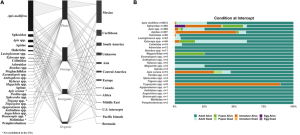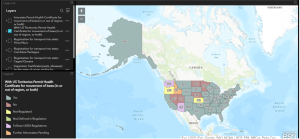Members of the UF/IFAS Honey Bee Research and Extension Laboratory led a working group composed of academic and USDA personnel from multiple Universities and Federal agencies, to review the legislation regulating movement of western honey bees (queens, nucs, and packages) among U.S. states and territories. Below is a summary of the research as well as a link to the full publication.
Background
Western honey bees (Apis mellifera L.) are native to western Asia, Europe, and Africa. Through migratory beekeeping and global commerce, western honey bees are now present on every continent, except Antarctica. They serve as the dominant pollinator species used globally in agriculture. The authors present a map comparing the level of movement of honey bee colonies in migratory beekeeping operations in 1987 and 2013 for pollination services of major agriculture and orchard crops (Fig 1). They also present information on intercepts of bees and wasps at U.S. ports (land, sea, air) from the last 20 years, with honey bees accounting for more than 80% of intercepts (Fig. 2).
Purpose
The purpose of this research was to summarize and review past and current honey bee movement within the U.S. and legislation regulating movement among U.S. states and territories. The authors discuss the history of honey bee imports into the U.S., imports that triggered the movement of several honey bee subspecies of interest within the Americas. Additionally, the authors outline the benefits and risks associated with moving honey bees within the U.S. Finally, the review covers potential risk mitigation strategies to ensure healthy bees and a strong beekeeping industry.


Key findings
- Honey bees were first brought to the U.S. as early as 1622 by English settlers. Multiple introductions and migratory beekeeping led to the dispersal of honey bees across environments and locations within the US.
- Today, the movement of bees into the United States is federally regulated under the Honey Bee Act; interstate honey bee movement is regulated by each state. The authors compiled current legislation, per state, in an interactive map for easy consultation. Please visit https://uofmd.maps.arcgis.com/apps/webappviewer/index.html?id=b01d1d7cc19d438d8a6af7ce179a4bca

- Moving honey bees within the United States is crucial to maintain a healthy food supply and beekeeping industry as well as a healthy economy.
- The accidental introduction of invasive honey bees and their pests is a continuous threat in the U.S. and risk mitigation strategies must be developed. The authors detailed case studies on how accidental introductions of pests (for example: Varroa destructor and Africanized bees) impacted the beekeeping industry.
Significance
This review compiled current regulations about honey bee movement among U.S. states and territories in a user-friendly interactive platform (see link above). In addition, the authors provide context for creating fair, equitable, standard best practices for honey bee movement across the U.S. given current regulations. This would help ensure the sustainability of the beekeeping industry and proper movement of honey bees among U.S. states and territories.
To read this publication, visit: https://doi.org/10.3389/fevo.2022.850600
This blog post was written by UF IFAS Honey Bee Lab Fall 2022 intern Katie Gray and revised by Amy Vu, Dr. Jose Marcelino, and Dr. Jamie Ellis.
Marcelino, J., Braese, C., Christmon, K., Evans, J.D., Gilligan, T., Giray, T., Nearman, A., Niño, E.L., Rose, R., Sheppard, W.S., vanEngelsdorp, D., Ellis, J.D. 2022. The movement of western honey bees (Apis mellifera L.) among U.S. states and territories: history, benefits, risks, and mitigation strategies. Frontiers in Ecology and Evolution, 10:850600. https://doi.org/10.3389/fevo.2022.850600.
Source: UF/IFAS Pest Alert
Note: All images and contents are the property of UF/IFAS.



